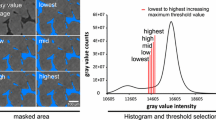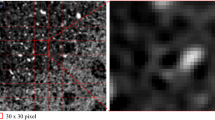Abstract
We apply multidimensional X-ray CT to quantify the porosity of Berea Sandstone by using both medical- and synchrotron-based X-ray radiation, so as to produce images of the same sample with mm- and micron-resolution, respectively. Three different samples are used and the obtained tomograms are compared by considering the spatial distribution of porosity values for the range of voxel sizes 0.25–16 mm3. The agreement between the two independent techniques is assessed by means of the concordance correlation coefficient. Statistically significant correlations are found for each sample up to the maximum resolution of the medical CT scanner, i.e. for images with a voxel size of \((0.5 \times 0.5 \times 1\,\hbox {mm})^{3}\). The direct comparison of images obtained by medical- and synchrotron-based X-ray radiation has a dual benefit. First, it objectively informs the segmentation step required for the binarization of the high-resolution synchrotron images that is otherwise prone to operator bias; in this context, the applicability of the proposed workflow is demonstrated with two widely applied locally adaptive thresholding algorithms, namely the hysteresis and the watershed methods. Secondly, once this calibration has occurred, the coupling of the two techniques allows analyzing porosity heterogeneity across a range of length-scales that spans over more than eight orders of magnitude. We anticipate that the ability to perform a true multi-scale experiment may represent the required point of departure for developing up-scaling approaches that capture the inherently complex heterogeneity of rocks.











Similar content being viewed by others
References
D. Wildenschild, A.P. Sheppard, Adv. Water Res. 51, 217 (2013)
F. Fusseis, X. Xiao, C. Schrank, F. De Carlo, J. Struct. Geol. 65, 1 (2014)
S. Wellington, H. Vinegar, J. Pet. Technol. 39, 885 (1987)
E.M. Withjack, SPE Form. Eval. 3, 696 (1988)
V. Cnudde, M. Boone, Earth Sci. Rev. 123, 1 (2013)
D. Silin, L. Tomutsa, S. Benson, T. Patzek, Transport Porous Media 86(2), 495 (2011)
M. Andrew, B. Bijeljic, M.J. Blunt, Geophys. Res. Lett. 40(15), 3915 (2013)
A.L. Herring, L. Andersson, D. Newell, J. Carey, D. Wildenschild, Int. J. Greenh. Gas Control 25, 93 (2014)
S.C.M. Krevor, R. Pini, L. Zuo, S.M. Benson, Water Resour. Res. 48(2), W02532 (2012)
S. Berg, S. Oedai, H. Ott, Int. J. Greenh. Gas Control 12, 478 (2013)
R. Pini, S.M. Benson, Water Resour. Res. 49(6), 3516 (2013)
M. Akbarabadi, M. Piri, Adv. Water Res. 52, 190 (2013)
R. Pini, S.C.M. Krevor, S.M. Benson, Adv. Water Res. 38, 48 (2012)
R.H. Brooks, A.T. Corey, Hydrol. Pap. 3, 1 (1964)
W. Murphy, J. Roberts, D. Yale, K. Winkler, Geophys. Res. Lett. 11(8), 697 (1984)
K.A. Klise, V.C. Tidwell, S.A. McKenna, Adv. Water Res. 31(12), 1731 (2008)
J.C. Perrin, S. Benson, Transport Porous Media 82(1), 93 (2010)
J.Q. Shi, Z. Xue, S. Durucan, Int. J. Greenh. Gas Control 5(1), 75 (2011)
B.L. Alemu, E. Aker, M. Soldal, Ø. Johnsen, P. Aagaard, Geophys. Prospect. 61(1), 235 (2013)
S. Krevor, R. Pini, B. Li, S. Benson, Geophys. Res. Lett. 38, L15401 (2011)
R. Pini, S.M. Benson, Geophys. Res. Lett. 40(15), 3903 (2013)
T. Tran, J. Hydrol. 183(1), 37 (1996)
A.D. Grader, A.B. Clark, T. Al-Dayyani, A. Nur, in Proceedings of the International Symposium of the Society of Core Analysts, Noordwijk aan Zee, The Netherlands, 27–30 September 2009
R.M. Sok, T. Varslot, A. Ghous, S. Latham, A.P. Sheppard, M.A. Knackstedt, Petrophysics 51(6), 379 (2010)
P. Lai, K. Moulton, S. Krevor, Chem. Geol. 411, 260 (2015)
R. Pini, Langmuir 30(37), 10984 (2014)
S. Akin, A.R. Kovscek, in Applications of X-ray Computed Tomography in the Geosciences, ed. by F. Mees, R.Swennen, M. Van Geet, P. Jacobs, vol 215 (Geological Society, London, 2003), pp. 23–38
H. Ott, K. de Kloe, M. van Bakel, F. Vos, A. van Pelt, P. Legerstee, A. Bauer, K. Eide, A. van der Linden, S. Berg, Rev. Sci. Instrum. 83(8), 084501 (2012)
Y. Zhang, O. Nishizawa, T. Kiyama, S. Chiyonobu, Z. Xue, Geophys. J. Int. 197(3), 1789 (2014)
B. Vega, A. Dutta, A.R. Kovscek, Transport Porous Media 101(1), 81 (2014)
E.J. Peters, W.D. Hardham, J. Pet. Sci. Eng. 4(2), 155 (1990)
S. Ganapathy, D.G. Wreath, M.T. Lim, B.A. Rouse, G.A. Pope, K. Sepehrnoori, SPE Form. Eval. 8(4), 273 (1993)
M. Honarpour, A. Cullick, N. Saad, N. Humphreys, J. Pet. Technol. 47, 980 (1995)
P. Iassonov, T. Gebrenegus, M. Tuller, Water Resour. Res. 45(9), 1 (2009)
H. Andrä, N. Combaret, J. Dvorkin, E. Glatt, J. Han, M. Kabel, Y. Keehm, F. Krzikalla, M. Lee, C. Madonna, Comput. Geosci. 50, 25 (2013)
P.C. Baveye, M. Laba, W. Otten, L. Bouckaert, P. Dello Sterpaio, R.R. Goswami, D. Grinev, A. Houston, Y. Hu, J. Liu, Geoderma 157(1), 51 (2010)
L. Leu, S. Berg, F. Enzmann, R. Armstrong, M. Kersten, Transport Porous Media 105(2), 451 (2014)
M.L. Porter, D. Wildenschild, Comput. Geosci. 14(1), 15 (2010)
C.E. Shannon, Proc. IRE 37(1), 10 (1949)
A. Buades, B. Coll, J.M. Morel, IPOL J. doi:10.5201/ipol.2011.bcm_nlm (2011)
H. Vogel, A. Kretzschmar, Geoderma 73(1), 23 (1996)
L. Vincent, P. Soille, I.E.E.E. Trans, Pattern Anal. Mach. Intell. 6, 583 (1991)
S. Schlüter, A. Sheppard, K. Brown, D. Wildenschild, Water Resour. Res. 50(4), 3615 (2014)
G. Kerckhofs, J. Schrooten, T. Van Cleynenbreugel, S.V. Lomov, M. Wevers, Rev. Sci. Instrum. 79(1), 013711 (2008)
N.J. Cox, Geomorphology 76(3), 332 (2006)
J.R. Taylor, An Introduction to Error Analysis, 2nd edn. (University Science Books, Mill Valley, 1997)
M. Chaouche, N. Rakotomalala, D. Salin, B. Xu, Y. Yortsos, Chem. Eng. Sci. 49(15), 2447 (1994)
J. Bear, Dynamics of Fluids in Porous Media (Dover, New York, 1988)
Acknowledgments
Dr. Claudio Madonna is grateful to Prof. Sally Benson, Department of Energy Resources Engineering, Stanford University (Stanford, CA, USA) for supporting his research visit. Special thanks go to Dr. Jonathan Ajo-Franklin and Dr. Marco Votolini, Lawrence Berkeley National Laboratory (Berkeley, CA, USA) for the acquisition and initial reconstruction of the synchrotron images.
Author information
Authors and Affiliations
Corresponding author
Appendix: Quantification of the mCT noise
Appendix: Quantification of the mCT noise
The use of tomograms obtained with a medical CT scanner on a voxel-by-voxel basis requires a careful appraisal of the uncertainty associated with readings at such high resolutions. A practical way for achieving this is to subtract images of scans taken at identical locations (e.g. two consecutive scans of the same slice); as described in [13], the obtained differences follow a Normal distribution function that is centred around zero and that is characterised by a given standard deviation. The latter is a measure of the “CT noise”. This analysis can be readily extended by (1) subtracting images that represent an average of multiple scans of the same slice and/or by (2) subtracting images obtained at increasing voxel sizes. Both methods can in fact effectively reduce image noise. Results from such exercise are shown in Fig. 12, where the “CT noise” is plotted as a function of the number of averaged scans n (represented in terms of \(1/\sqrt{n}\) in the figure) for the three different voxel sizes considered in this study, namely \((0.5 \times 0.5 \times 1)\), \((1 \times 1 \times 1)\) and \((2 \times 2 \times 1)\,\hbox {mm}^{3}.\) Upon application of classic rules of error propagation, it can be shown that [13]:
where \(\sigma _{\mathrm{\Delta }_n}\) (the “CT noise”) is the standard deviation that represents the distribution of CT values obtained upon subtracting two images, which have been obtained from an average n independent scans each, while \(\sigma _{\mathrm{vox}}\) is the uncertainty in CT units associated to a single voxel. In Fig. 12, the symbols are the experimentally obtained \(\sigma _{\mathrm{\Delta }_n}\) from a set of 20 consecutive scans of the same slice of the Berea Sandstone sample used in this study, while the lines represent the behaviour predicted by Eq. 4. Accordingly, \(\sigma _{\mathrm{vox}}\) takes a value of 18.4, 15.0 and 8.8 HU for a voxel of size \((0.5 \times 0.5 \times 1)\), \((1 \times 1 \times 1)\) and \((2 \times 2 \times 1)\,\hbox {mm}^{3},\) respectively. When 20 consecutive scans are taken, this uncertainty reduces to 4.1, 3.3 and 2.0 HU, respectively. In an analogous manner, it can be shown that porosity values predicted from Eq. 1 are affected by an uncertainty \(\sigma _{{\phi },n}\):
where \(\phi _n\) represents a voxel porosity obtained upon combination of dry and wet images, which have been obtained from an average n independent scans each [13]. Accordingly, porosity uncertainties are reported on the right-hand side y-axis in Fig. 12 and the corresponding 2D porosity maps are shown in Fig. 2.
Analysis of the noise affecting tomograms acquired with a medical CT scanner at various voxel sizes, namely \((2 \times 2 \times 1)\), \((1\times 1 \times 1)\) and \((0.5 \times 0.5 \times 1)\,\hbox {mm}^{3}.\) The CT noise is defined as the standard deviation, \(\sigma _{\mathrm{\Delta }_n},\) that represents the distribution of CT values obtained upon subtracting two images, which have been obtained from an average n independent scans each. Experimentally determined values are given by the symbols, while the lines are predictions from Eqs. 4 (left-hand y-axis) and 5 (right-hand y-axis). X-ray CT images were acquired on a General Electric Hi-Speed CT/i X-ray computed tomography scanner by selecting a tube current of 200 mA and an energy level of the radiation of 120 keV
Rights and permissions
About this article
Cite this article
Pini, R., Madonna, C. Moving across scales: a quantitative assessment of X-ray CT to measure the porosity of rocks. J Porous Mater 23, 325–338 (2016). https://doi.org/10.1007/s10934-015-0085-8
Published:
Issue Date:
DOI: https://doi.org/10.1007/s10934-015-0085-8





